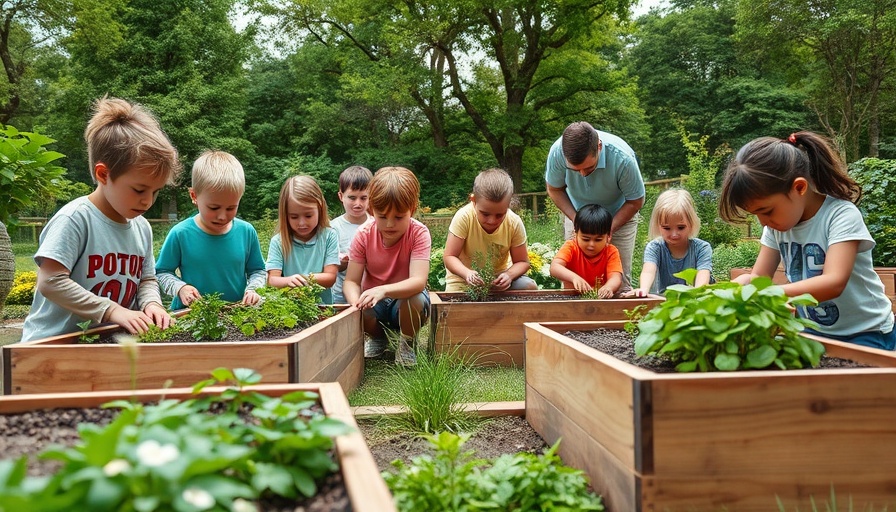
Connecting Education and Nature: The Case for School Gardens
In an era where technology dominates children’s lives, the push toward integrating nature with education is a refreshing and much-needed shift. School gardens, often viewed as simple plots of soil, are in fact transformative educational tools that cultivate not only plants but also lifelong learning and healthful habits in students.
The Benefits of Gardening Education
School gardens offer a myriad of educational benefits, creating tangible links between students and the natural world. According to experts, these gardens enhance academic performance by providing hands-on, experiential learning opportunities. From science lessons about plant biology to math applications in measuring garden beds and even art classes inspired by nature, a school garden effectively enriches various subjects.
Furthermore, research backs the positive impact of gardens on children’s nutrition. Studies have revealed that children attending schools with active gardening programs are significantly more likely to consume fruits and vegetables. For instance, an evaluation by FoodCorps showed that schools providing consistent, hands-on nutrition education can lead children to increase their fruit and vegetable intake by as much as three times during school lunches.
Steps to Creating a School Garden
Setting up a school garden involves thoughtful planning. Here’s a streamlined guide:
- Plan and Design: Assess the space for sunlight, accessibility, and water. Engage the community in planning to foster interest and ownership.
- Get Permissions: Secure necessary approvals from the school authorities and communicate the educational benefits to encourage buy-in from the wider school community.
- Gather Supplies: Collect essential materials like raised garden beds, soil, compost, seeds, and tools. Involving students in supply gathering can enhance their investment in the project.
Promoting Health and Wellness through Gardening
The advantages of school gardens extend beyond academics. According to Leah Shafer in her article on school gardens, these initiatives combat the modern health crisis characterized by childhood obesity and poor nutrition. By providing accessible exposure to fresh produce, gardens offer a hands-on approach to teaching children about healthy eating. This initiative becomes a practical solution for communities that face challenges like food deserts.
“It’s an antidote to an often sterile, technology-driven education,” says Shafer. “Gardens are dynamic learning environments that stimulate children’s curiosity about nature, food, and wellness,” she adds.
Engaging Students and Fostering Community
To maximize the impact of school gardening initiatives, it’s vital to embrace a community approach. Integrating various subject lessons into garden activities not only enriches education but also builds a sense of camaraderie among the students, teachers, and local gardening experts. “The success of a garden program lies in integrating it into the broader educational framework,” explains Bettina Elias Siegal, a noted expert on child nutrition.
Moreover, sharing the harvest with the community can foster community connections, reinforcing the garden's role as not just an educational tool but a local resource.
Continuous Learning and Best Practices
Your school garden can become a center for continuous exploration and learning. Educators are encouraged to incorporate garden activities into lessons across the curriculum, creating a multi-disciplinary approach. Whether it’s calculating the area of a garden bed in math or discussing the history of agriculture in social studies, the possibilities are vast.
Additionally, building emotional connections to the food they cultivate can influence children’s willingness to try new foods. This can be enhanced by encouraging tasting sessions, where students sample freshly harvested vegetables. “It’s all about changing perceptions,” says Eva Ringstrom, director of impact at FoodCorps, emphasizing the role of experiential learning.
Final Thoughts: Growing Minds with Gardens
The movement toward school gardens embodies a holistic approach to education—melding academic learning with real-world applications. As schools across the country recognize the profound benefits of outdoor education and gardening, a new generation of environmentally-conscious, health-oriented students is taking root.
Are you interested in fostering a garden program at your school? Getting involved is simpler than you think. Consider leading a project today to prepare students for a brighter, greener, and healthier future.
 Add Row
Add Row  Add
Add 


 Add Row
Add Row  Add
Add 

Write A Comment